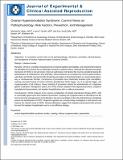| dc.contributor.author | Alper, Michael Myron | |
| dc.contributor.author | Smith, Laura | |
| dc.contributor.author | Sills, Eric Scott | |
| dc.date.accessioned | 2011-06-14T18:18:59Z | |
| dc.date.issued | 2009 | |
| dc.identifier.citation | Alper, Michael M., Laura P. Smith, and Eric Scott Sills. 2009. Ovarian Hyperstimulation Syndrome: Current Views on Pathophysiology, Risk Factors, Prevention, and Management. Journal of Experimental & Clinical Assisted Reproduction 6:3. | en_US |
| dc.identifier.issn | 1743-1050 | en_US |
| dc.identifier.uri | http://nrs.harvard.edu/urn-3:HUL.InstRepos:4911698 | |
| dc.description.abstract | Objective: To summarize current views on the pathophysiology, risk factors, prevention, clinical features, and management of Ovarian Hyperstimulation Syndrome (OHSS). Design: Literature review. Results: OHSS is a condition characterized by increased capillary permeability, and experimental evidence has identified a provocative link to pathologic vasoactive cytokine actions. Although the ultimate physiologic mechanism of OHSS is not yet known, there are well-known risk factors that must be considered during the administration of medications to treat infertility. Clinical features are consequences of third-spaced intravascular fluid, and OHSS may become life-threatening secondary to thromboembolism or compromised pulmonary or cardiovascular function. Cornerstones of prevention have historically included cycle cancellation, coasting, decreased dosing of human chorionic gonadotropin (hCG) trigger, use of an agonist trigger, and cryopreservation of all embryos. Newer methods of prevention include the administration of a dopamine agonist medication. Management options for OHSS include outpatient transvaginal paracentesis, outpatient transabdominal paracentesis, and inpatient hospitalization with or without paracentesis. Conclusions: OHSS continues to be a serious complication of assisted reproductive therapy (ART), with no universally agreed upon best method of prevention. Coasting and cryopreservation of all embryos are the most commonly used approaches in the literature, but cycle cancellation is the only method that can completely prevent the development of OHSS. Dopamine agonists are currently being investigated to both prevent and improve the clinical course in OHSS. Recent publications suggest that outpatient paracentesis both prevents the need for inpatient hospitalization and is a cost-effective strategy. | en_US |
| dc.language.iso | en_US | en_US |
| dc.publisher | The Sims Institute Press Ltd. | en_US |
| dc.relation.isversionof | http://www.ncbi.nlm.nih.gov/pmc/articles/PMC2868304/ | en_US |
| dash.license | LAA | |
| dc.subject | ovarian hyperstimulation syndrome | en_US |
| dc.subject | ascites | en_US |
| dc.subject | coasting | en_US |
| dc.subject | embryo cryopreservation | en_US |
| dc.subject | paracentesis | en_US |
| dc.title | Ovarian Hyperstimulation Syndrome: Current Views on Pathophysiology, Risk Factors, Prevention, and Management | en_US |
| dc.type | Journal Article | en_US |
| dc.description.version | Version of Record | en_US |
| dc.relation.journal | Journal of Experimental & Clinical Assisted Reproduction | en_US |
| dash.depositing.author | Alper, Michael Myron | |
| dc.date.available | 2011-06-14T18:18:59Z | |
| dash.affiliation.other | HMS^Obstetrics Gynecology and Repro. Bio. - BIDMC | en_US |
| dash.affiliation.other | HMS^Stipendees - Div of Medical Sciences | en_US |
| dash.contributor.affiliated | Alper, Michael | |


